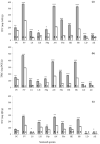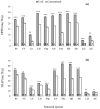Optimisation of Ultrasound Frequency, Extraction Time and Solvent for the Recovery of Polyphenols, Phlorotannins and Associated Antioxidant Activity from Brown Seaweeds
- PMID: 32403273
- PMCID: PMC7281582
- DOI: 10.3390/md18050250
Optimisation of Ultrasound Frequency, Extraction Time and Solvent for the Recovery of Polyphenols, Phlorotannins and Associated Antioxidant Activity from Brown Seaweeds
Abstract
This study investigates ultrasound assisted extraction (UAE) process parameters (time, frequency and solvent) to obtain high yields of phlorotannins, flavonoids, total phenolics and associated antioxidant activities from 11 brown seaweed species. Optimised UAE conditions (35 kHz, 30 min and 50% ethanol) significantly improved the extraction yield from 1.5-fold to 2.2-fold in all seaweeds investigated compared to solvent extraction. Using ultrasound, the highest recovery of total phenolics (TPC: 572.3 ± 3.2 mg gallic acid equivalent/g), total phlorotannins (TPhC: 476.3 ± 2.2 mg phloroglucinol equivalent/g) and total flavonoids (TFC: 281.0 ± 1.7 mg quercetin equivalent/g) was obtained from Fucus vesiculosus seaweed. While the lowest recovery of TPC (72.6 ± 2.9 mg GAE/g), TPhC (50.3 ± 2.0 mg PGE/g) and TFC (15.2 ± 3.3 mg QE/g) was obtained from Laminaria digitata seaweed. However, extracts from Fucus serratus obtained by UAE exhibited the strongest 1,1-diphenyl-2-picryl-hydrazyl (DPPH) scavenging activity (29.1 ± 0.25 mg trolox equivalent/g) and ferric reducing antioxidant power (FRAP) value (63.9 ± 0.74 mg trolox equivalent/g). UAE under optimised conditions was an effective, low-cost and eco-friendly technique to recover biologically active polyphenols from 11 brown seaweed species.
Keywords: antioxidant capacity; conventional extraction; macroalgae; phlorotannin; polyphenols; ultrasound assisted extraction.
Conflict of interest statement
The authors declare no conflicts of interest.
Figures




Similar articles
-
Evaluation of Ultrasound, Microwave, Ultrasound-Microwave, Hydrothermal and High Pressure Assisted Extraction Technologies for the Recovery of Phytochemicals and Antioxidants from Brown Macroalgae.Mar Drugs. 2021 May 27;19(6):309. doi: 10.3390/md19060309. Mar Drugs. 2021. PMID: 34071764 Free PMC article.
-
Optimization of Phlorotannins Extraction from Fucus vesiculosus and Evaluation of Their Potential to Prevent Metabolic Disorders.Mar Drugs. 2019 Mar 8;17(3):162. doi: 10.3390/md17030162. Mar Drugs. 2019. PMID: 30857204 Free PMC article.
-
Optimization of Extraction of Phlorotannins from the Arctic Fucus vesiculosus Using Natural Deep Eutectic Solvents and Their HPLC Profiling with Tandem High-Resolution Mass Spectrometry.Mar Drugs. 2023 Apr 23;21(5):263. doi: 10.3390/md21050263. Mar Drugs. 2023. PMID: 37233457 Free PMC article.
-
Antioxidant and Antidiabetic Properties of Phlorotannins from Ascophyllum nodosum Seaweed Extracts.Molecules. 2023 Jun 23;28(13):4937. doi: 10.3390/molecules28134937. Molecules. 2023. PMID: 37446599 Free PMC article. Review.
-
Polyphenols from Brown Seaweeds (Ochrophyta, Phaeophyceae): Phlorotannins in the Pursuit of Natural Alternatives to Tackle Neurodegeneration.Mar Drugs. 2020 Dec 18;18(12):654. doi: 10.3390/md18120654. Mar Drugs. 2020. PMID: 33353007 Free PMC article. Review.
Cited by
-
Evaluation of Ultrasound, Microwave, Ultrasound-Microwave, Hydrothermal and High Pressure Assisted Extraction Technologies for the Recovery of Phytochemicals and Antioxidants from Brown Macroalgae.Mar Drugs. 2021 May 27;19(6):309. doi: 10.3390/md19060309. Mar Drugs. 2021. PMID: 34071764 Free PMC article.
-
Influence of Oxidation and Dialysis of Phlorotannins on Bioactivity and Composition of Ultrasound-Assisted Extracts from Ascophyllum nodosum.Mar Drugs. 2022 Nov 11;20(11):706. doi: 10.3390/md20110706. Mar Drugs. 2022. PMID: 36421984 Free PMC article.
-
A Comparative Review of Alternative Fucoidan Extraction Techniques from Seaweed.Mar Drugs. 2025 Jan 7;23(1):27. doi: 10.3390/md23010027. Mar Drugs. 2025. PMID: 39852529 Free PMC article. Review.
-
Improvement of Alginate Extraction from Brown Seaweed (Laminaria digitata L.) and Valorization of Its Remaining Ethanolic Fraction.Mar Drugs. 2024 Jun 15;22(6):280. doi: 10.3390/md22060280. Mar Drugs. 2024. PMID: 38921591 Free PMC article.
-
Biocosmetics Made with Saccharina latissima Fractions from Sustainable Treatment: Physicochemical and Thermorheological Features.Mar Drugs. 2023 Nov 29;21(12):618. doi: 10.3390/md21120618. Mar Drugs. 2023. PMID: 38132939 Free PMC article.
References
-
- Mouritsen O.G., Dawczynski C., Duelund L., Jahreis G., Vetter W., Schröder M. On the human consumption of the red seaweed dulse (Palmaria palmata (L.) Weber & Mohr) J. Appl. Phycol. 2013;25:1777–1791.
-
- Holdt S.L., Kraan S. Bioactive compounds in seaweed: Functional food applications and legislation. J. Appl. Phycol. 2011;23:543–597. doi: 10.1007/s10811-010-9632-5. - DOI
-
- Wang L., Park Y.J., Jeon Y.J., Ryu B. Bioactivities of the edible brown seaweed, Undaria pinnatifida: A review. Aquaculture. 2018;495:873–880. doi: 10.1016/j.aquaculture.2018.06.079. - DOI
-
- Bordoloi A., Goosen N. Green and integrated processing approaches for the recovery of high-value compounds from brown seaweeds. Adv. Bot. Res. 2019 doi: 10.1016/bs.abr.2019.11.011. - DOI
Publication types
MeSH terms
Substances
Grants and funding
LinkOut - more resources
Full Text Sources
Medical
Miscellaneous

